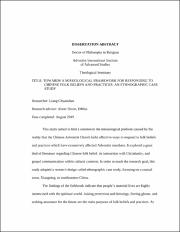Towards a missiological framework for responding to Chinese folk beliefs and practices : an ethnographic case study
Abstract
This study aimed to find a solution to the missiological problem caused by the reality that the Chinese Adventist Church lacks effective ways to respond to folk beliefs and practices which have extensively affected Adventist members. It explored a great deal of literature regarding Chinese folk belief, its interaction with Christianity, and gospel communication within cultural contexts. In order to reach the research goal, this study adopted a research design called ethnographic case study, focusing on a coastal town, Xiangning, in southeastern China.
The findings of the fieldwork indicate that people’s material lives are highly intertwined with the spiritual world. Asking protection and blessings, fearing ghosts, and seeking assurance for the future are the main purposes of folk beliefs and practices. At
the same time, there is a generally harmonious relationship between Xiangning Adventists and folk beliefs and practices, and this harmony frequently leads to syncretism. Furthermore, the fieldwork also demonstrates that the local Adventist Church’s missional efforts still lag far behind the real needs of mission reality and there is significant room for the church to improve in promoting its gospel communication.
The interpretation of the fieldwork shows that Chinese folk beliefs and practices are undergirded by at least 6 values which extend to the cognitive, affective, and evaluative dimensions of Chinese culture. Supported by missiological and biblical principles, this study eventually proposes a missiological framework for gospel communication as a response to Chinese folk beliefs and practices. This framework is a contour consisting of 5 main points: (1) Countercultural contextualization provides a general principle for framework construction. (2) Bidirectional construction from above and below provides a general methodology for framework construction. (3) Worldview transformation is the core and purpose of gospel communication. (4) Critical contextualization is a concrete method in choosing among accepting, rejecting, or modifying old customs. (5) The 3 dimensions of Chinese folk beliefs and practices indicate the depth in which the Gospel can penetrate a society. All these 5 points correlate with each other and form a basic framework upon which further mission studies, evangelism, and pastoral counseling may be conducted.


